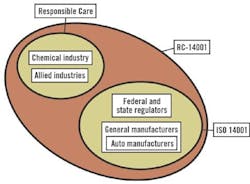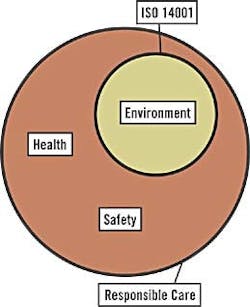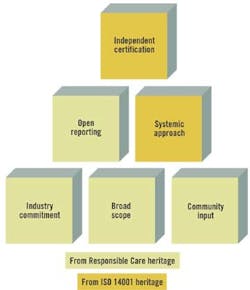Responsible Care Meets ISO
The Responsible Care-14001 (RC-14001) environmental management system (EMS), created jointly by the American Chemistry Council (ACC) and the Registrar Accreditation Board (RAB), was formally adopted in 2002.
RC-14001 combines the elements of the Responsible Care initiative with the ISO 14001 standard. The new EMS is designed to help the chemical and allied industries continually improve their environmental performance, standardize and certify environmental improvement practices, and expand their EMSs to include health and safety, product stewardship and communications programs.
Under the auspices of ACC and RAB, RC-14001 has been tested at two pilot locations: BASF in Wyandotte, Mich., and Arch Chemicals in Rochester, N.Y.* BASF's facility achieved certification this past August. Arch Chemicals' Phase 1 audit took place in November, and the Phase 2 audit is scheduled for January 2003. The integrated management systems are examined and certified by RAB-accredited ISO 14001 auditors who have been cross-trained in Responsible Care requirements.
Core Supporters of RC-14001
Do you need a new EMS?
Does the chemical industry need another EMS? It already has ISO 14001, the Europeans' Eco-Management and Audit Scheme (EMAS), British Standard (BS) 7750, the American Petroleum Institute's (API) Safety and Environmental Management Program (SEMP, API Recommended Practice 75), the U.S. Environmental Protection Agency's (EPA) Compliance-Based EMS and ACC's Responsible Care management system. Beyond these recognized programs, hundreds of company-specific EMSs also have been developed by corporations finding the recognized systems too confining or too confusing.
The emergence of RC-14001 is best understood within the context of ISO 14001 and its extraordinary growth since its adoption in 1996 as an international standard for guiding EMS development. To date, an estimated 36,000 ISO 14001 registrations exist worldwide.
U.S. environmental professionals often fail to appreciate the momentum of ISO 14001 because the United States is behind the rest of the developed world in ISO 14001 implementation. Less than 5 percent of all worldwide certifications can be attributed to the United States.
Just as when ISO 9000 (the standard for quality management systems) first was introduced in 1987, Europe and the Pacific Rim have eagerly adopted ISO 14001, propelling it forward, but out of the direct view of many observers in the United States.
Broader Scope of Responsible Care
In Europe, the growth of ISO 14001 has begun to squeeze out competing EMSs. EMAS registrations have fallen far behind ISO 14001 registrations. In fact, a recent revision to EMAS embraces the verbatim text of ISO 14001 requirements, guaranteeing that all ISO 14001-certified European companies would satisfy the requirements of EMAS as well. The situation for BS 7750 is even more dismal ," that standard was withdrawn in 1997 under competitive pressure from ISO 14001.
Despite the standard's relatively slow start here, however, U.S. ISO 14001 registrations now are surging, with the automotive, electronics and chemical industries leading the field. At least four major drivers are responsible for this recent wave of U.S. ISO 14001 certifications:
Encouragement by federal and state regulatory agencies. EPA Administrator Christie Whitman recently issued clear guidance indicating that the agency looks favorably on companies with EMSs. She identified ISO 14001 specifically as an EMS that produces reliable improvements in performance.
A number of states (e.g., Massachusetts, Texas, California and Wisconsin) enacted or proposed environmental regulatory incentives for companies that have adopted EMSs such as ISO 14001.
Mandates from automotive manufacturers. Ford, General Motors, DaimlerChrysler and Toyota insist their direct (Tier I) suppliers achieve ISO 14001 certification to continue to do business with them. Although deadlines differ, depending on the customer, most affected direct suppliers must be registered to ISO 14001 no later than the end of 2003.
Demands by foreign ownership. With the increasingly international character of U.S. businesses, more and more plants find themselves under European or Pacific Rim ownership. Owners in those regions find ISO 14001 to be an effective vehicle for imposing uniform environmental management approaches across national boundaries. The foreign owners typically find ISO 14001 to be an effective tool for managing environmental operations, which the owners otherwise might view an incomprehensible tangle of regulatory-driven compliance initiatives with no ties to corporate norms.
Improved bottom-line performance. In addition to enhanced general awareness of environmental issues at all facility levels, resulting in improved environmental performance, many organizations have realized substantial economic benefits from an ISO 14001 EMS. Moreover, firms registered to ISO 14001 are perceived by the business community as effective managers of environmental risk. Consequently, these companies might enjoy other financial benefits such as a lower cost of capital and a higher investor rating.
Isn't Responsible Care enough?
The rollout of the first elements of the Responsible Care initiative began 10 years before the advent of ISO 14001. Although the initiative started as a targeted program to avoid catastrophes such as Bhopal, it gradually evolved and grew in scope.
Over the years, the Responsible Care initiative has expanded to encompass an imposing range of issues such as health and safety, product stewardship and community relations. By 1998, the initiative even included an independent certification process of its own, known as Management Systems Verification (MSV).
Even the most ardent ISO 14001 supporter must admit that the Responsible Care initiative deserves much admiration. With its expansive scope and noble aims, the initiative inherently challenges its adherents more broadly and more ambitiously than does ISO 14001. For example, ISO 14001 imposes no health and safety requirements, leaves the extent of product stewardship up to the organization and requires no communication of environmental performance to the host community.
Customers have two chief objections. First, the Responsible Care initiative is considered by some skeptics outside of the chemical industry to be a collection of nebulous aspirations instead of a true management system in the classic "plan-do-check-act" tradition. Second, some skeptics question the rigor of the MSV process. They point out that MSV is primarily an informal assessment of a company's Responsible Care program by other industry members and community representatives, lacking independence and accreditation by an authorized recognized body.
Faced with growing customer dem-ands and increased global interest in ISO 14001, ACC proposed a creative solution: Synergize the best of ISO 14001 and the Responsible Care initiative to formulate a technical specification for third-party dual certification to both standards.
Building Blocks of RC-14001's Credibility
Combining the strengths of two systems
The Responsible Care initiative and ISO 14001 actually have different strengths. ISO 14001 focuses narrowly on environmental management and emphasizes rigor in certification. The Responsible Care initiative encompasses health, safety, community, customers and communication improvements. By combining the two, companies get a rigorous, broad standard that can yield outstanding performance.
Under RC-14001, an organization can build a single environmental, health and safety (EH&S) management system that is simultaneously consistent with both standards, while providing customers and other stakeholders with a greater level of assurance about its operations. To aid firms interested in pursuing this new integrated standard, ACC created the RC-14001 Management System Technical Specification, which systematically reconciles each element of ISO 14001 with the corresponding specifications of the Responsible Care initiative. It resolves each "discrepancy" in favor of the stricter requirement. As a result, RC-14001 offers several distinct requirements over ISO 14001 alone, including:
An expanded aspect/impact assessment process.
Required proactive outreach to the host community.
Environmental performance reporting to stakeholders.
Required emphasis on upstream supplier issues and downstream customers.
Qualification, training and review of contractors, transporters and other service providers.
Businesses in the chemical and allied industries with existing management systems are the most natural candidates for RC-14001. Within this group, the businesses with the most hazardous chemicals are the most likely to feel a sense of urgency to upgrade to RC-14001.
By upgrading an existing Responsible Care program to RC -14001, a company can add depth, rigor and credibility to its existing programs. Conversely, by upgrading an existing ISO 14001 EMS to RC-14001, an organization can add openness and breadth to its management system.
Gilbertsen is a program manager and Kowalski is a senior program manager in ENSR International's Warrenville, Ill., office. ENSR teamed up with Newark, Del.-based Verrico Associates LLC, a management and Responsible Care consulting firm, to monitor and help develop RC-14001 programs. Together they provide awareness training, internal auditor level training, gap analyses and comprehensive implementation assistance. Both authors can be reached at (630) 636-1700.




